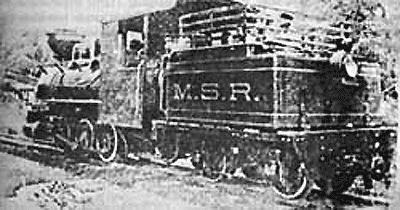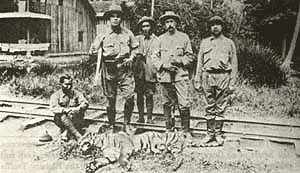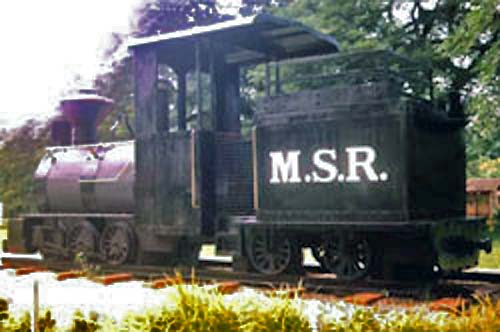The Muar State Railway
In the late 19th century Muar was the largest and most important district in the State of Johor and the first to be significantly developed. Parit Jawa was an important area under Muar due to its plantations of gambir, coconut, Pinang and other commercial plants. The journey from Parit Jawa to Muar town was difficult as there were no proper roads and travellers by sea or river were exposed to pirate attacks. On 13th November 1887 a discussion was held between Resident Tungku Sulaiman and the head for the Land Office and Agriculture Affairs of Muar district, Dato' Bentara Luar. During this discussion an agreement was reached to build a railway between the two places to serve the population south of Muar town and improve the transportation of goods. It would also provide free transportation for school children who went to the English school in Muar town. Construction commenced in early 1889 and was done mostly by Malays, and Javanese workers who had migrated in masses to the Malay peninsular. Most of these Javanese immigrants did not have permanent jobs and their pay was low. The initial stage of the railway from Jalan Sulaiman in Muar town to Parit Jawa was completed in 1890. All materials were supplied from Europe. The train consisted of a steam engine, 5 passenger coaches with outward facing seats, divided into first class, second class and third class (which was always full), three goods vans and two further vans. The fare for passengers was five sen per mile. In 1894, the railway was extended another three miles to Sungai Pulai, by which time the train ran five times a day. There were five permanent stations and eight temporary stations along the railway. Two locomotives were ordered from Black Hawthorn on 28 January 1889, being works numbers 962 and 963, while works number 1017 was ordered on 5 July 1890.
|
Permanent stations:
1. Bandar Maharani, Muar 2. Parit Bakar 3. Parit Jawa 4. Parit Pecah 5. Parit Pulai
|
Temporary stations:
1. Parit Perupok 2. Parit Keroma 3. Parit Raja 4. Parit Unas 5. Parit Samsu 6. Parit Jamil 7. Parit Bulat 8. Parit Seri Menanti
|
October
2010. I have found a number of newspaper articles containing snippets of
information related to the Muar Railway and will transcribe them here as and
when time permits. Originally a
single department administered the railway and waterworks.
From the Straits Times weekly issue of 7th June 1889.
The Bangkok, from Singapore, came in on the morning of the 27th (Monday), having five tongkangs in tow laden with materials for the waterworks and the Muar railway. The tongkang with materials for the latter service was dropped at Bandar Maharani, and the other four were taken up to Pengkalan Bukit, where they will discharge.
A coolie was carrying up the breakfast of the overseer of the party laying down the pipes from the impounding reservoir. On his way he happened to see three tigers some distance in front of him, and thinking discretion the better part of valour, made tracks home as fast as his legs could carry him, as he thought it better that his master should be wanting his breakfast than that he should be the breakfast of the tigers.
----------
From the Straits Times weekly issue of 11th February 1890.
Muar, 5th February - The trial trip with the first engine of the Muar railway was made yesterday. The party consisted of Unkoo Othman, Inche Mahomed bin Mahboob, the Commissioner, Inche Mahomed Dhoon, the Treasurer, and Mr. Garland, Commissioner of Public Works. Jalan Maharani and Jalan Salieman were thronged with spectators, and the success of the whole business was complete. There was considerable difficulty in fitting up the engine, but Mr. Orchard's ability and untiring efforts were not wasted, and every praise is due him, considering all the difficulties he had to contend against.
The station premises and engine shed are being run up, and will soon be completed. The carriage shed, as well as several passenger and goods vehicles, have been finished, and the latter ready for use.
A train goes out today to bring in 300 piculs of goods from the interior. It is evident from this that the line will be appreciated, and the country opened up.
Muar is a fast growing town and on all sides new houses and buildings are springing up.
The Sultan's new Istana and the Resident's house will be picturesque buildings when completed. The new mosque will soon be ready and there is talk of having new Government Offices, Barracks and Gaol. It is hoped that during the year masonry drains will be constructed throughout the town.
The waterworks have not been completed, but it is expected that they will be so shortly.
Three Catholic priests arrived here last night from Malacca. Their object, it is believed, is to establish a Mission and build a chapel.
The mail service from Singapore is very bad. No mail has been received since the 31st ultimo, and yet four steamers have arrived from that port. This neglect must naturally handicap business relationships with the outer world.
----------
From the Straits Times weekly issue 22 April 1890
Johore, 16th April - I hear the Muar Railway is a success, and is paying, results being better than were expected.
----------
From the Straits Times Weekly Issue, 13 September 1892
The last part of a report on the Kranji Electric Line is relevant and follows:
It may also be mentioned that the gauge and the carriages which are at present in work at this experimental stage are in every way suitable for work on the Muar Railway. We understand that this course was adopted so that, in case of the thing not turning out successful, all the rolling stock along with the rails and sleepers could be transferred to the Muar Railway.
----------
From The Straits Times, 11 March 1902
This day in history - 1890 - Opening of Muar Railway and Waterworks.
----------
From The Straits Times, 16 December 1902
Johore notes, December 15th - Mr Godden has accepted the appointment of Engineer for the Muar Railway and Waterworks.
----------
From The Straits Times, 3 December 1903
Bandar Maharani, 30th November - extract - In connection with the extension of the Muar State Railway from Parit Jawa to Batu Pahat, it is understood that 3,000 sleepers have been requisitioned from Johore. On the last trip of the Boon San however she only brought down about 300 sleepers so the work cannot be proceeded with at a very rapid rate. There is a fair sized workshop in the immediate vicinity of the railway station. The fitters and workmen are all Malays and seem to manage very well. At present the staff are building 'bogey' carriages, under the supervision of Mr. W. A. Leach, the General Manager, for use on the railway.
This is a very large article about life in Muar in 1903 and can be accessed here for those interested.
----------
From The Straits Times, 14 October 1905
Gun accident at Muar - Mr. Leach seriously injured - We regret to hear that Mr. W. A. Leach, Traffic Superintendent of the Muar Railway, met with a bad gun accident at Muar, yesterday morning, about 11.30 o'clock. It seems that Mr. Leach was cleaning a gun which was loaded, when it went off accidentally, and the charge struck Mr. Leach in the face, seriously injuring his jaw and the roof of his mouth. Medical aid was at once summoned and Dr. Grant, of Muar, did all that was possible in the circumstances, and sent for Dr. Wilson, the Principal Medical Officer at Johore. We understand that Mr. Leach is in a critical condition.
----------
From the Eastern Daily Mail and Straits Morning Advertiser, 3 January 1906
A spark from Muar - There is a Railway yclept "The Muar State Railway" running from Muar Town to Parit Java. On both sides of the railway line there are betel nut, cocoanut, and fruit plantations belonging to Chinese and Malays and all the villages adjoining are thickly populated. To get to these places one and all are obliged to travel by this railway, that being the only means of communication. This special brand of railway - I call it because of its fireworks - has a reputation for burning passenger's clothes by the sparks emitted from the funnel of the engine. Syed Omar of Muar has lost in the fire, caused by such sparks, a headgear which cost him $12; another amusing instance is that of a Javanese who found his bundle of new sarongs intended for sale in flames before reaching their destination. Dear Mr. Editor, you will be still more surprised to hear that in addition to the above horrors, a Chinese coolie passenger lost his towchang! There is not a day passes without similar complaints. Dato Sitiah, the State Commisioner, a person in authority, who is presumed to run the territory, has also been a victim, and lost a beautiful silk umbrella by fire caused by the sparks above-mentioned. The ticket collectors can always be seen with their uniforms burned. Could not some improvement be made?
Yours faithfully,
N. G. H.
Singapore, Jan 1st.
Note: "yclept" is an olde English word meaning "called".
----------
From the Singapore Free Press 7 June 1907
Death of Mr. Robert Cameron
The many friends of Mr. Robert Cameron, who for forty-five years had been in the Johore Government Service, will be sorry to hear that he died at Muar on Wednesday morning from pneumonia. Mr. Cameron went to Muar to take up the post of Superintendent of the Muar Railway which was left vacant by the death oh Mr. W. A. Leach who accidentally shot himself with a Snider rifle over a year ago. His death was not unexpected as he had been ailing some time and on Tuesday, when he began to sink, a telegram was sent to his son Mr J. Cameron, who is in the employ of the Municipality here, calling him to his father's side. The wire was despatched from Malacca at 3 am on Wednesday, but the deceased succumbed an hour later. He was so highly thought of in Johore that his remains are to be taken there for interment. They will be put in a hermetically sealed coffin and conveyed to Johore in the Johore Government steamer Chohong.
----------
From The Straits Times, 22 August 1916
Muar Railway
Sunshine writes from Muar as follows:- Very few, outside the Johore State, are aware of the existence of the Muar railway. Over 30 years ago when Muar was a village consisting of about 30 huts, the late Sultan Abu Bakar caused the railway to be opened and since then the village has taken the name of Bandar Maharani and today possesses a population of 9,534 within the town limit. Outside the town limits are to be seen smart looking new type bungalows, enclosed with beautiful gardens, all along the line. The Muar railway has a distance of about 14 miles at present and an extension of 14 miles is waiting to be plate-laid. This extension brings Batu Pahat in touch with Bandar Maharani. This is the only railway in the east which is managed by the native officials without outside assistance. There are five outgoing trains and five in-coming trains daily, each carrying traffic to its full capacity. The passenger train coaches are of bogie type and have the appearance of the Federated Malay State railway mail train coaches. There is room for an additional train leaving Sungei Pulai at about 5 a.m., and arriving at Bandar Maharani at 7 a.m., for those bringing vegetables or going to market. Government employees and schoolboys who live by the railway line would be greatly convenienced. The number of people who walk in the morning from Sungei Pulai to Parit Java, and from this side of Parit Java to Bandar Maharani, has been so great that there is an urgent need for a morning train.
----------
From The Straits Times, 15 February 1922
The Muar Minstrels were much in evidence on Saturday night last on the occasion of the celebration of Chap Go Meh. They paraded the town in a lorry with a piano and stringed instruments and discoursed music on the way. They visited the principal Chinese houses where, needless to say, they were hospitably entertained. The association is composed of 23 members under the leadership of Mr. J. W. Bennett, the Superintendent of the Muar Railway, and he hopes in good time to make it a feature in the amenities of Muar.
I have recently found that a Mr John Colin Campbell was Superintendent of the Muar State Railway and the Muar Waterworks until his death in 1902. He had possibly previously worked for the Selangor State Railway. This information was supplied to me by one of his descendants.
The following are
quotes from other sources:
Originally a single department administered the railway and waterworks. In 1894 the Muar State Railway with its own establishment had come into existence.
Ref: Amarjit Kaur, “Bridge and Barrier: Transport and Communications in Colonial Malaya 1870-1957”, Singapore, Oxford University Press: 1985.
In 1908, the head of Muar State Railway was Encik Mohd. Taib Abdullah, who replaced J.C. Campbell. The passenger train service ceased operation in 1927 due to losses and introduction of faster and simpler mode of transportation. It was then used only to carry rocks and stones to make roads. The stones were taken from Bukit Mor Quarry which is one of the biggest quarry in Johor.
Given the above data it is at present difficult to assess who held which senior posts on the railway and waterworks for how long so I will research some more before trying to create a proper list. In the meantime, the following posts have variously been assigned amongst the names that follow:
Superintendent of Railway, Superintendent of Railway and Waterworks, Superintendent of Waterworks, Traffic Superintendent, General Manager, Railway Traffic Manager, Engineer, railway and waterworks. The dates below apply only as where I found them mentioned.
Mr. Orchard until 17th September 1890
Mr. John Colin Campbell from 17th September 1890 until 1902 (died aged 56)
Mr. Godden 1902-1903
Mr. W. A. Leach 1903 to 13 October 1905
Mr. Robert Cameron October 1905 to June 1907
Encik Mohd. Taib Abdullah 1908-?
Mr. J. W. Bennett by November 1922
The railway service was very profitable. The main factors that contributed to the profitability were that the trains catered for both passengers and freight, the increase in economic activities and the cessation sea transportation. New locomotives arrived from America during WWI. In 1915, income for Muar State Railway reached RM 86,701.92 compared to an estimated expenditure of RM 63,216.77. With this positive development, His Majesty the Sultan of Johor suggested extending the railway service up to the Batu Pahat river but it was not done due to financial reasons and geographical conditions. There was a lot of soft ground along the way; it had to be piled every time the train passed through the area resulting in an increase in expenditure. Profitability began to decline when the engine was getting old and increasing costs were being incurred in maintaining the railway and stations. With the opening of a road called Jalan Abdul Rahman from Maharani town to Parit Jawa in 1925, the Muar State Railway began to suffer from the increasing competition and ceased its operation in 1929.
A dummy locomotive has been put on display in a local park since that time. A recent (2013) examination of this reveals that it is nothing more than an "apprentice piece" put together with cut sheet metal plates with a few genuine parts like lamps and couplings thrown in to make it look like the real thing. In reality it is nothing more than a children's toy, albeit life-size!

Above: The locomotive as running in service.

His Majesty the late Sultan Ibrahim seen here with a tiger which he has shot at Parit Samsu, on the Muar Railway, in 1915. Standing from left, His Majesty the late Sultan Ibrahim, Orangkaya Hasran bin Hj. Abd. Jabar (founder of Parit Jawa), Mr. Brown (Manager of Olak Plantation), and Dato' Abdullah bin Jaafar. Sitting in front, Kapitan Yahya bin Abu Talib.

Contributed by Hassni Bin Hussin's Web Site (Bahasa Malaysia)
Page created 8th September 2006
Updated 30th June 2015.
This page has been visited times.